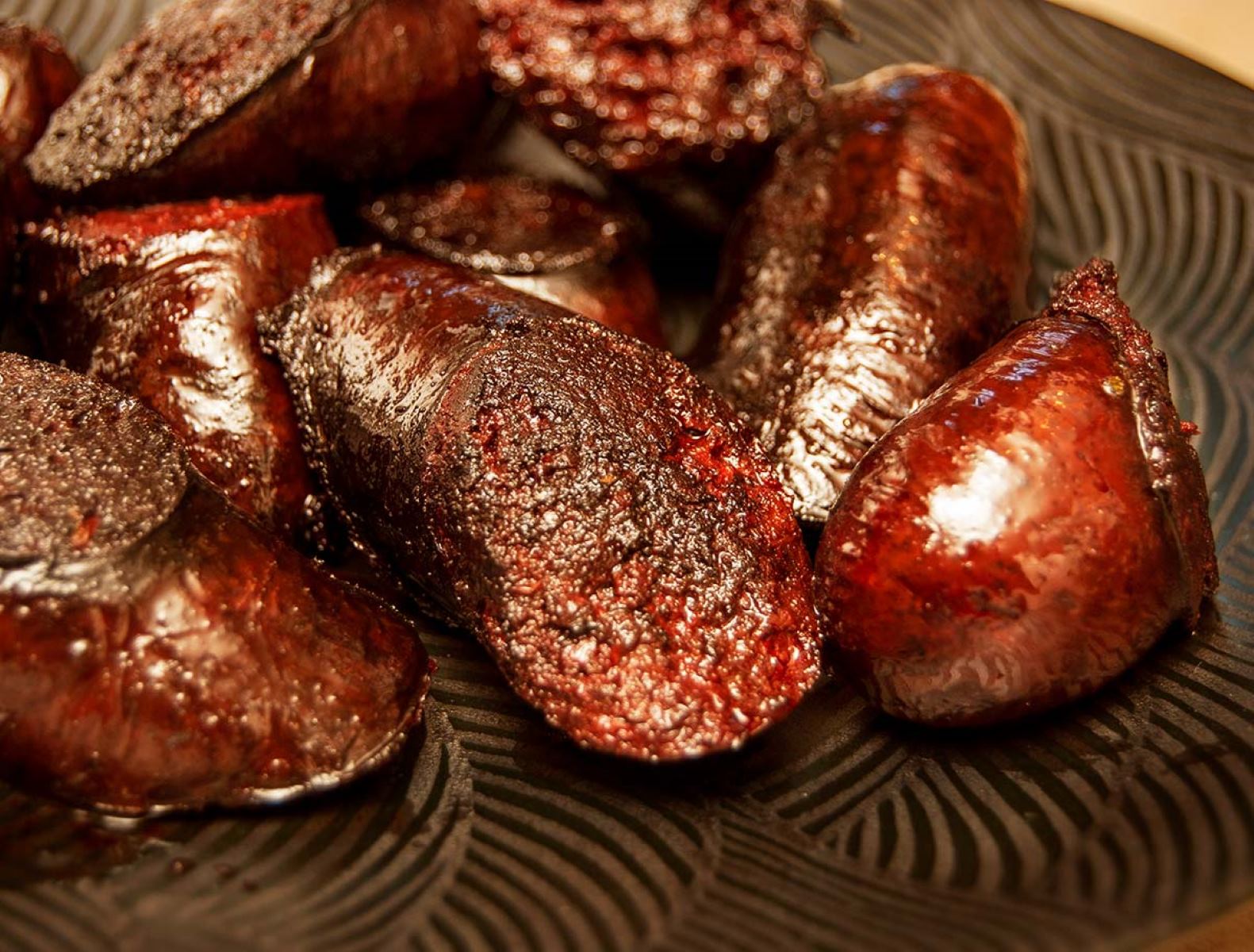Home>Food and Cooking>The Shocking Truth Behind The Taboo Of Blood Sausage In The United States


Food and Cooking
The Shocking Truth Behind The Taboo Of Blood Sausage In The United States
Published: February 10, 2024
Uncover the taboo of blood sausage in the US and explore its surprising history and cultural significance. Discover more about food and cooking traditions.
(Many of the links in this article redirect to a specific reviewed product. Your purchase of these products through affiliate links helps to generate commission for Regretless.com, at no extra cost. Learn more)
Table of Contents
Introduction
Blood sausage, also known as black pudding, boudin noir, or morcilla, is a type of sausage made by cooking blood with a filler until it is thick enough to congeal when cooled. This unique culinary creation has a rich history that spans across cultures and continents, yet it remains a controversial and often misunderstood delicacy, especially in the United States.
The consumption of blood sausage dates back centuries, with evidence of its existence in ancient Greece, Rome, and China. Throughout history, various cultures have developed their own versions of blood sausage, incorporating local ingredients and culinary traditions to create distinct flavors and textures. From the rich and savory boudin noir in France to the spicy and aromatic morcilla in Spain, blood sausage reflects the diverse and dynamic nature of global gastronomy.
Despite its widespread popularity in many parts of the world, blood sausage has faced resistance and skepticism in certain regions, particularly in the United States. The reasons behind this reluctance are multifaceted, encompassing cultural, religious, and dietary considerations. The taboo surrounding blood sausage has led to misconceptions and misconstrued notions about its taste, preparation, and nutritional value.
In this article, we will delve into the fascinating history of blood sausage, exploring its cultural significance and culinary evolution. We will also address the health concerns and nutritional value associated with this unique delicacy, shedding light on its potential benefits and drawbacks. Furthermore, we will examine the specific reasons behind the taboo of blood sausage in the United States and discuss potential avenues for changing perceptions and fostering a greater appreciation for this traditional food.
As we embark on this journey through the world of blood sausage, we invite you to set aside any preconceived notions and approach this topic with an open mind. By gaining a deeper understanding of the complexities and nuances surrounding blood sausage, we can challenge the prevailing stigma and embrace the diversity of global cuisine.
History of Blood Sausage
The history of blood sausage is a tapestry woven with threads of tradition, innovation, and culinary ingenuity. Dating back to ancient civilizations, the origins of blood sausage can be traced to a time when resourcefulness and sustainability were paramount in the kitchen. Across different cultures and regions, the utilization of blood in cooking was not only a means of minimizing waste but also a way to create hearty and flavorful dishes.
In ancient Greece, blood sausage, known as "melas zomos," was a staple in the Hellenic diet. The Greeks combined blood with grains, herbs, and spices, creating a savory sausage that provided a source of nourishment and sustenance. Similarly, the Romans embraced blood sausage, incorporating it into their culinary repertoire as a testament to their resourceful approach to gastronomy.
Moving eastward, the Chinese developed their own version of blood sausage, known as "xiangchang." This revered delicacy featured a harmonious blend of blood, rice, and seasonings, reflecting the intricate flavors and textures that define Chinese cuisine. Across Europe, blood sausage manifested in various forms, each influenced by the local ingredients and culinary traditions of the region. From the rich and velvety boudin noir of France to the robust and aromatic morcilla of Spain, blood sausage became an integral part of the gastronomic identity of these countries.
During the Middle Ages, blood sausage continued to evolve, with recipes adapting to the availability of ingredients and the preferences of the populace. The advent of the spice trade further enriched the flavor profiles of blood sausage, as exotic spices from distant lands found their way into the kitchens of Europe. As explorers traversed the globe, they brought back a treasure trove of culinary inspirations, infusing blood sausage with new and exciting ingredients.
In the modern era, blood sausage has transcended its humble origins to become a celebrated delicacy in many parts of the world. While its history is deeply rooted in tradition, contemporary chefs and food enthusiasts have reimagined blood sausage, elevating it to new heights of culinary artistry. Whether served alongside gourmet accompaniments or integrated into avant-garde culinary creations, blood sausage continues to captivate the palates of adventurous epicureans.
The history of blood sausage is a testament to the enduring legacy of culinary traditions and the dynamic evolution of global gastronomy. By understanding the historical context and cultural significance of blood sausage, we gain a deeper appreciation for this time-honored delicacy and the diverse culinary tapestry from which it emerged.
Cultural Perspectives on Blood Sausage
Blood sausage holds a significant place in the culinary traditions of numerous cultures around the world, each offering a unique perspective on its preparation, consumption, and symbolic significance. From Europe to Asia, blood sausage has been embraced as a testament to resourcefulness, creativity, and the art of transforming humble ingredients into culinary marvels.
In European culinary heritage, blood sausage is revered for its rich and robust flavors, often regarded as a symbol of tradition and community. In countries such as France, Germany, and the United Kingdom, blood sausage is a beloved component of regional cuisines, with each locale boasting its own distinctive variation. Whether enjoyed as a hearty breakfast staple or featured in celebratory feasts, blood sausage serves as a culinary emblem that connects individuals to their cultural roots and ancestral culinary practices.
In Spain and Portugal, morcilla and chouriço, respectively, are esteemed manifestations of blood sausage, showcasing the Iberian Peninsula's penchant for bold and savory flavors. These revered delicacies are often integral to festive gatherings and play a pivotal role in the tapestry of Iberian gastronomy, embodying the spirit of conviviality and shared culinary heritage.
In Asian cultures, particularly in China and Korea, blood sausage holds a revered place in traditional cuisine, celebrated for its depth of flavor and symbolic significance. In China, xiangchang, a type of blood sausage, is a cherished delicacy that reflects the intricate balance of flavors and textures inherent in Chinese culinary traditions. Similarly, in Korea, sundae, a type of blood sausage, is a beloved comfort food that resonates with the warmth of home-cooked meals and communal dining experiences.
The cultural perspectives on blood sausage underscore its multifaceted role as a culinary symbol, a testament to ancestral traditions, and a source of communal connection. By exploring the diverse cultural attitudes toward blood sausage, we gain insight into the profound impact of this humble yet revered delicacy on the culinary identities of societies around the world.
Health Concerns and Nutritional Value
When examining the nutritional value of blood sausage, it is crucial to consider its composition and the potential health concerns associated with its consumption. Blood sausage is a rich source of essential nutrients, including iron, protein, and various vitamins and minerals. However, it is also high in cholesterol and saturated fat, which can pose health risks if consumed in excess.
One of the primary nutritional benefits of blood sausage is its high iron content. Iron is essential for the production of hemoglobin, the protein in red blood cells that carries oxygen to tissues throughout the body. Consuming blood sausage can be particularly beneficial for individuals with iron-deficiency anemia, a condition characterized by low levels of red blood cells or hemoglobin. The iron found in blood sausage is heme iron, which is more easily absorbed by the body compared to non-heme iron found in plant-based sources.
In addition to iron, blood sausage provides a significant amount of protein, which is essential for muscle growth, tissue repair, and overall health. Protein also plays a crucial role in maintaining a feeling of fullness and satiety, making it a valuable component of a balanced diet.
Despite these nutritional benefits, it is important to be mindful of the potential health concerns associated with consuming blood sausage. Due to its high cholesterol and saturated fat content, excessive consumption of blood sausage may contribute to an increased risk of heart disease and other cardiovascular conditions. Individuals with existing cholesterol-related health issues should exercise caution when incorporating blood sausage into their diet.
Furthermore, the preparation and processing of blood sausage can vary, impacting its overall nutritional profile. Traditional recipes may include a higher proportion of animal fat and sodium, which can further contribute to health concerns if consumed in large quantities.
In summary, while blood sausage offers valuable nutritional benefits, including a rich source of iron and protein, it is essential to consume it in moderation and as part of a balanced diet. Understanding the nutritional value and potential health concerns associated with blood sausage empowers individuals to make informed dietary choices and enjoy this traditional delicacy responsibly.
The Taboo of Blood Sausage in the United States
In the United States, blood sausage carries a stigma that has contributed to its status as a niche and polarizing culinary offering. The aversion to blood sausage in American culture can be attributed to a combination of factors, including cultural perceptions, dietary preferences, and food safety concerns.
One of the primary reasons for the taboo surrounding blood sausage in the United States is the cultural aversion to consuming blood as a food ingredient. Unlike in many European and Asian cultures where blood-based dishes are embraced as culinary traditions, the American palate has historically been less receptive to such offerings. The perception of blood as an unconventional and unappealing ingredient has contributed to the marginalization of blood sausage in the American culinary landscape.
Dietary preferences and health consciousness also play a significant role in perpetuating the taboo of blood sausage in the United States. With an emphasis on lean proteins and health-conscious eating, American dietary trends often prioritize foods perceived as clean, wholesome, and low in saturated fats. Blood sausage, with its rich and savory profile derived from blood and fat, contradicts the prevailing dietary preferences, further distancing it from mainstream acceptance.
Furthermore, food safety concerns and regulatory standards have influenced the perception of blood sausage in the United States. The stringent regulations surrounding the handling and consumption of blood products have contributed to a cautious approach to blood sausage within the American food industry. Concerns about the potential risks associated with consuming undercooked blood products have led to a hesitancy among consumers and food establishments to embrace blood sausage as a mainstream culinary offering.
The taboo of blood sausage in the United States reflects a complex interplay of cultural, dietary, and regulatory factors that have shaped the American culinary landscape. Despite its rich history and cultural significance in other parts of the world, blood sausage continues to occupy a contentious and marginalized position within the American food culture.
Understanding the reasons behind the taboo of blood sausage in the United States provides valuable insight into the intricate dynamics of culinary acceptance and rejection within a diverse and evolving gastronomic society. As perceptions and attitudes toward food continue to evolve, there is potential for a shift in the cultural acceptance of blood sausage, paving the way for a broader appreciation of its unique flavors and historical significance.
Overcoming the Taboo: Changing Perceptions
The journey toward overcoming the taboo of blood sausage in the United States involves a multifaceted approach that addresses cultural, culinary, and educational dimensions. By fostering a deeper understanding of the historical and cultural significance of blood sausage, culinary enthusiasts and advocates can play a pivotal role in reshaping perceptions and nurturing a greater appreciation for this traditional delicacy.
Education and Culinary Exploration:
Educational initiatives and culinary exploration serve as powerful tools in dispelling misconceptions and demystifying the preparation and consumption of blood sausage. Through cooking classes, workshops, and educational events, individuals can gain firsthand experience in crafting and savoring blood sausage, allowing them to appreciate its nuanced flavors and culinary heritage. By engaging in open dialogue and experiential learning, participants can develop a more informed and nuanced perspective on blood sausage, transcending preconceived notions and embracing its cultural and gastronomic significance.
Culinary Innovation and Integration:
Incorporating blood sausage into contemporary culinary creations and innovative dishes offers an avenue for broadening its appeal and introducing it to a wider audience. By collaborating with chefs, food artisans, and culinary influencers, the integration of blood sausage into diverse and imaginative recipes can showcase its versatility and flavor potential. From fusion cuisine to modern interpretations of traditional dishes, the creative integration of blood sausage into mainstream culinary offerings can challenge existing taboos and inspire culinary curiosity.
Cultural Appreciation and Inclusivity:
Promoting cultural appreciation and inclusivity within the culinary landscape is essential for overcoming the taboo of blood sausage. By recognizing the cultural significance of blood sausage in various global traditions and celebrating its role as a culinary symbol, individuals can foster an environment of respect and openness toward diverse gastronomic experiences. Embracing the rich tapestry of global cuisine, including the traditions surrounding blood sausage, encourages a spirit of inclusivity and curiosity, transcending cultural barriers and promoting culinary diversity.
Advocacy and Awareness:
Advocacy efforts aimed at raising awareness and dispelling misconceptions about blood sausage are instrumental in reshaping perceptions and fostering greater acceptance. Through engaging storytelling, informative campaigns, and advocacy initiatives, individuals can shed light on the historical and cultural significance of blood sausage, emphasizing its place in the global culinary mosaic. By amplifying the voices of advocates and enthusiasts, the narrative surrounding blood sausage can evolve, leading to a more nuanced and appreciative understanding of this traditional delicacy.
By embracing a holistic approach that encompasses education, culinary innovation, cultural appreciation, and advocacy, the journey toward changing perceptions of blood sausage in the United States can pave the way for a more inclusive and diverse culinary landscape. As individuals engage with the rich history and cultural significance of blood sausage, they can transcend taboos, challenge misconceptions, and foster a newfound appreciation for this time-honored delicacy.
Conclusion
In conclusion, the taboo of blood sausage in the United States reflects a complex interplay of cultural, dietary, and regulatory factors that have contributed to its marginalized status within the American culinary landscape. Despite its rich history, cultural significance, and revered status in numerous global traditions, blood sausage continues to face resistance and skepticism in the United States. The aversion to consuming blood as a food ingredient, prevailing dietary preferences, and concerns regarding food safety and regulatory standards have collectively shaped the perception of blood sausage as a niche and polarizing delicacy.
However, the journey toward changing perceptions and overcoming the taboo of blood sausage presents an opportunity to foster a deeper appreciation for this traditional delicacy. By engaging in educational initiatives, culinary exploration, and advocacy efforts, individuals can challenge misconceptions, demystify the preparation and consumption of blood sausage, and celebrate its cultural and gastronomic significance. Through the creative integration of blood sausage into contemporary culinary creations and the promotion of cultural appreciation and inclusivity, there is potential for a shift in the cultural acceptance of blood sausage, paving the way for a broader appreciation of its unique flavors and historical legacy.
As we navigate the diverse and dynamic landscape of global cuisine, it is essential to approach traditional delicacies such as blood sausage with an open mind and a spirit of curiosity. By embracing the rich tapestry of culinary traditions and engaging in meaningful dialogue, we can transcend cultural barriers and challenge preconceived notions, fostering an environment of inclusivity and appreciation for the diverse gastronomic experiences that enrich our culinary heritage.
In the journey toward changing perceptions of blood sausage, we have the opportunity to celebrate the resilience and adaptability of culinary traditions, honor the cultural significance of traditional delicacies, and cultivate a more nuanced and informed approach to embracing the diversity of global cuisine. Through education, innovation, advocacy, and cultural appreciation, we can embark on a transformative journey that transcends taboos, fosters understanding, and paves the way for a more inclusive and diverse culinary landscape.














